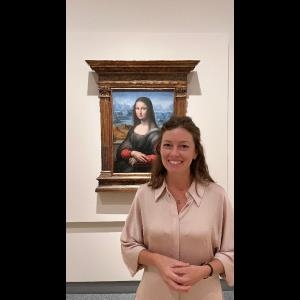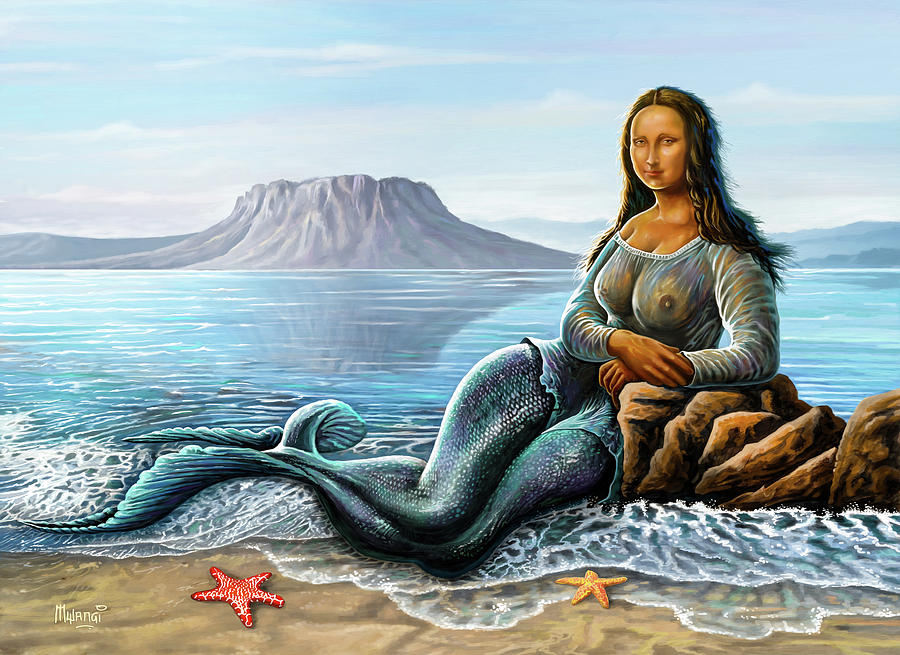The Mona Lisa - The Collection - Museo Nacional del Prado

This version of the Mona Lisa (Louvre) was painted by one of Leonardo’s pupils. The fact that each pentimento, or change, in Leonardo’s original (to the bust, outline of the veil and position of the fingers) is repeated here suggests that the two works were created simultaneously. There are also differences with respect to the original, in the unfinished landscape and on the face. Overall, the panel seems to reflect an intermediate stage in the creation of the Louvre painting.
A comparison of the infrared reflectograms of the two panels reveals identical details concealed beneath the surface, particularly in the creation of the figures, which illustrates a parallel working process and reveals that the copyist reproduced much of the process of elaboration with which the Louvre painting was created, albeit without aiming to imitate it. The figures are identical in size and shape and were transferred by tracing, undoubtedly from the same cartoon. The preparatory underdrawing of the original reveals the principal lines of the setting and intermediary phasesin the execution that are repeated in the copy, which has very precise underdrawing and is drawn up using different materials and implements. In the copy, some of the transferred outlines were reinforced and corrected freehand and there are visible lines of free drawing that are not related to the forms on the surface or to the underlying ones in the original. Rather, they reflect hesitations and trials by the artist of this panel and refer to a more complex process than that of a mere copy. There is also one more important fact: many of the “pentimenti” detected in the original (significant or minor) are repeated in the underlying image on the panel in the Prado. They include an identical change in position to the outline of the two heads in relation to the painted surface and slight adjustments to the outline of the right cheek and neck. These modifications could have happened in either direction: not only did the pupil make corrections while the master was working on and refining the original but some of the pupil´s errors may have suggested adjustments to Leonardo for his own work, particularly in the landscape which is notably simplified with regard to the initial one, as the Prado panel reflects. Only someone working alongside the master would have witnessed the adjustments that he made to the work in progress.
As was habitual in Leonardo´s studio, the materials are of extremely high quality and have survived in almost perfect condition. With the exception of the type of wood, which is walnut in the copy and poplar in the original, the other materials and the creation of the underlying work is similar. Both paintings have an oil-based, whiteish ground while the Prado´s has a orangeish priming, also with an oil binder, of a tone similar to that observed in works by Leonardo and the Milan studio. In formal terms, the two works are the same but the Prado panel is not comparable to the Mona Lisa in the Louvre in terms of quality and handling. The method of applying the paint is one of the most significant differences and the one that defines the final image of the sitters.
The Prado panel is a carefully painted portrait and despite its overall hardness, it has very subtle details that can be perceived from close up on the lips and hands. The copyist did not imitate Leonardo´s handling and aimed to dissimulate his brushstrokes, which are only perceptible in the unfinished areas and, under a microscope, in the flesh tones. The stroke is also individualised in the underlying, freehand drawing. Another interesting aspect of the pictorial technique revealed by a comparison between the two panels is that the shadows of the flesh tones in the original seem to have been constructed by adding thin, superimposed layers of umber over a reflective white ground. However, the copyist worked in the opposite sense and covered areas of the orangeish priming with a grey wash in order to construct the shadows, allowing it to show through under a lighter coloured glaze. The tonal transition on the cheeks is modified with small reddish brushstrokes.
The landscapes in both works have the same evanescent appearance but the one that has reappeared in the copy is unfinished. It includes rock formations that Leonardo drew in Milan around 1508-11 and which are present below the surface of the prototype. This detail supports the hypothesis that the Prado version corresponds to a moment prior to the completion of the original, which Leonardo modified at a moment when the copyist could no longer see it or that his panel remained in Milan when Leonardo went to Rome in 1513, and could not continue working on it. The copyist must have remained with Leonardo for a lengthy period, specialising in copying the works that the master most appreciated prior to his departure for Rome or France.
At the present time no independent works have been identified by this copyist´s hand. There is no doubt that the imprecision and delicacy of Leonardo´s painting is quite different to the precise technique of the artist who painted the Prado panel.












-
 Copy of the Mona Lisa24 janeiro 2025
Copy of the Mona Lisa24 janeiro 2025 -
 AI generated modern Mona Lisa slammed for catering to the 'male24 janeiro 2025
AI generated modern Mona Lisa slammed for catering to the 'male24 janeiro 2025 -
 What Can Light Tell Us About the Mona Lisa?24 janeiro 2025
What Can Light Tell Us About the Mona Lisa?24 janeiro 2025 -
 Mona Lisa Mediafusion Entertainment24 janeiro 2025
Mona Lisa Mediafusion Entertainment24 janeiro 2025 -
 Monalisa Mermaid Digital Art by Anthony Mwangi - Pixels Merch24 janeiro 2025
Monalisa Mermaid Digital Art by Anthony Mwangi - Pixels Merch24 janeiro 2025 -
 MonaLisa Shan Painting by Shan Kannan24 janeiro 2025
MonaLisa Shan Painting by Shan Kannan24 janeiro 2025 -
 The Intriguing Tale of How Mona Lisa Was Stolen and Became a24 janeiro 2025
The Intriguing Tale of How Mona Lisa Was Stolen and Became a24 janeiro 2025 -
 The Mona Lisa Painting of Leonardo Da Vinci at Louvre Editorial24 janeiro 2025
The Mona Lisa Painting of Leonardo Da Vinci at Louvre Editorial24 janeiro 2025 -
 47 Unexpected Versions Of The Mona Lisa Reimagined By Digital24 janeiro 2025
47 Unexpected Versions Of The Mona Lisa Reimagined By Digital24 janeiro 2025 -
 Monalisa with Cat Graphic · Creative Fabrica24 janeiro 2025
Monalisa with Cat Graphic · Creative Fabrica24 janeiro 2025
-
 Gym Rat Keychain, Weightlifting Keychain, Gym Keychain, Workout Keychain, Bodybuilding Keychain, Weightlifting Gifts24 janeiro 2025
Gym Rat Keychain, Weightlifting Keychain, Gym Keychain, Workout Keychain, Bodybuilding Keychain, Weightlifting Gifts24 janeiro 2025 -
 História O pai do ano - Imagine Roronoa Zoro - História escrita24 janeiro 2025
História O pai do ano - Imagine Roronoa Zoro - História escrita24 janeiro 2025 -
 Dead Rising, Microsoft Xbox 36024 janeiro 2025
Dead Rising, Microsoft Xbox 36024 janeiro 2025 -
 Top 10 Strongest God Of Highschool Characters24 janeiro 2025
Top 10 Strongest God Of Highschool Characters24 janeiro 2025 -
 Rent Roller Coaster Tycoon Adventures Deluxe on PlayStation 524 janeiro 2025
Rent Roller Coaster Tycoon Adventures Deluxe on PlayStation 524 janeiro 2025 -
 KK Vojvodina - Wikipedia24 janeiro 2025
KK Vojvodina - Wikipedia24 janeiro 2025 -
 HWYB Jetstream Sam from Metal Gear Rising: Revengeance? : r/WhatWouldYouBuild24 janeiro 2025
HWYB Jetstream Sam from Metal Gear Rising: Revengeance? : r/WhatWouldYouBuild24 janeiro 2025 -
017 COD MW CAMPAIGN - MELHOR HISTÓRIA DE TODOS OS TEMPOS24 janeiro 2025
-
 The Last of Us Bomb This City (Scene Episode 2) on Make a GIF24 janeiro 2025
The Last of Us Bomb This City (Scene Episode 2) on Make a GIF24 janeiro 2025 -
 Healthcare health medicine hospital ícone de laboratório24 janeiro 2025
Healthcare health medicine hospital ícone de laboratório24 janeiro 2025
